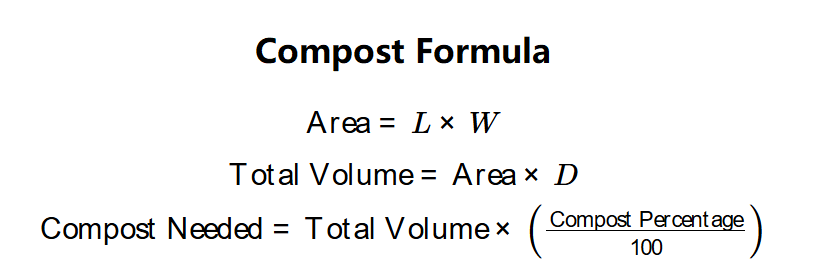1. What is the Compost Calculator?
Definition: This calculator computes the volume of compost needed for a garden, lawn, or raised bed based on the area, desired compost depth, and compost-soil mix ratio.
Purpose: It helps gardeners and farmers determine the exact amount of compost required, ensuring healthy soil without over- or under-application, reducing waste and costs.
2. How Does the Calculator Work?
The calculator uses the following equations:
- \( \text{Area} = L \times W \)
- \( \text{Total Volume} = \text{Area} \times D \)
- \( \text{Compost Needed} = \text{Total Volume} \times \left(\frac{\text{Compost Percentage}}{100}\right) \)
Where:
- \( L, W \): Length and width of the area (each converted to feet for calculation based on selected unit: mm, cm, m, inch, feet, yd);
- \( D \): Depth of compost application (converted to feet for calculation: mm, cm, inch, feet);
- \( \text{Compost Percentage} \): Percentage of compost in the soil-compost mix (e.g., 25%);
- \( \text{Total Volume} \): Volume of the soil-compost mixture, in cubic feet;
- \( \text{Compost Needed} \): Volume of compost required, convertible to ft³, m³, L, in³, cm³.
Steps:
- Enter the area length (\( L \)) and its unit (mm, cm, m, inch, feet, yd).
- Enter the area width (\( W \)) and its unit (mm, cm, m, inch, feet, yd).
- Enter the desired compost depth (\( D \)) and its unit (mm, cm, inch, feet).
- Enter the compost percentage in the mix (default 25%).
- Convert length, width, and depth to feet for calculation.
- Calculate the area: \( \text{Area} = L \times W \).
- Calculate the total volume: \( \text{Total Volume} = \text{Area} \times D \).
- Calculate compost needed: \( \text{Compost Needed} = \text{Total Volume} \times \left(\frac{\text{Compost Percentage}}{100}\right) \).
- Convert the compost volume to the selected unit (ft³, m³, L, in³, cm³).
- Display the result formatted in scientific notation if the absolute value is less than 0.001, otherwise with 4 decimal places.
3. Importance of Compost Calculation
Calculating the correct amount of compost is crucial for:
- Soil Health: Compost enriches soil with nutrients, improves microbial activity, and enhances plant growth.
- Cost Efficiency: Avoids over-purchasing compost, saving money and reducing waste.
- Environmental Impact: Reduces the need for chemical fertilizers, protecting local ecosystems from runoff pollution.
4. Using the Calculator
Example 1 (Garden Bed, Metric Units): Calculate the compost needed for a garden bed:
- Area Length: \( L = 3 \, \text{m} \), convert to ft: \( 3 \times 3.28084 \approx 9.8425 \, \text{ft} \);
- Area Width: \( W = 2 \, \text{m} \), convert to ft: \( 2 \times 3.28084 \approx 6.5617 \, \text{ft} \);
- Compost Depth: \( D = 5 \, \text{cm} \), convert to ft: \( 5 \div 30.48 \approx 0.1640 \, \text{ft} \);
- Compost Percentage: 25%;
- Area: \( \text{Area} = 9.8425 \times 6.5617 \approx 64.5832 \, \text{ft}^2 \);
- Total Volume: \( \text{Total Volume} = 64.5832 \times 0.1640 \approx 10.5916 \, \text{ft}^3 \);
- Compost Needed: \( \text{Compost Needed} = 10.5916 \times \left(\frac{25}{100}\right) \approx 2.6479 \, \text{ft}^3 \);
- Convert to L: \( 2.6479 \times 28.3168 \approx 74.9747 \, \text{L} \);
- Result: Compost Needed = 74.9747 L.
Example 2 (Lawn Topdressing, Mixed Units): Calculate the compost needed for topdressing a lawn:
- Area Length: \( L = 30 \, \text{ft} \);
- Area Width: \( W = 20 \, \text{yd} \), convert to ft: \( 20 \times 3 = 60 \, \text{ft} \);
- Compost Depth: \( D = 0.25 \, \text{inch} \), convert to ft: \( 0.25 \div 12 \approx 0.0208 \, \text{ft} \);
- Compost Percentage: 100% (topdressing with pure compost);
- Area: \( \text{Area} = 30 \times 60 = 1800 \, \text{ft}^2 \);
- Total Volume: \( \text{Total Volume} = 1800 \times 0.0208 \approx 37.5 \, \text{ft}^3 \);
- Compost Needed: \( \text{Compost Needed} = 37.5 \times \left(\frac{100}{100}\right) = 37.5 \, \text{ft}^3 \);
- Convert to m³: \( 37.5 \div 35.3147 \approx 1.0619 \, \text{m}^3 \);
- Result: Compost Needed = 1.0619 m³.
5. Frequently Asked Questions (FAQ)
Q: What is the recommended compost depth for a garden?
A: For gardens or raised beds, mix 1–2 inches of compost into the top 6–8 inches of soil. For topdressing lawns, apply 1/4 to 1/2 inch of compost.
Q: Why use a 25% compost mix?
A: A 25% compost, 75% soil mix is recommended to balance nutrient levels and prevent over-concentration, which can harm plants. Some plants may tolerate higher percentages—check specific plant requirements.
Q: How do I convert compost volume from cubic feet to liters?
A: Multiply the volume in cubic feet by 28.3168 to get the volume in liters.
 Home
Home
 Back
Back
